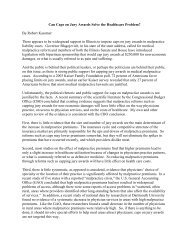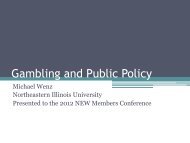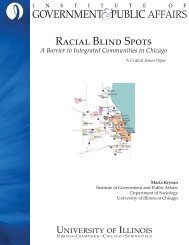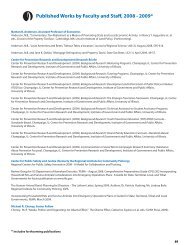The Illinois Report 2013 - Institute of Government & Public Affairs ...
The Illinois Report 2013 - Institute of Government & Public Affairs ...
The Illinois Report 2013 - Institute of Government & Public Affairs ...
You also want an ePaper? Increase the reach of your titles
YUMPU automatically turns print PDFs into web optimized ePapers that Google loves.
Anderson<br />
Ross<br />
Rethinking Property Taxation<br />
By Nathan B. Anderson and Rob Ross<br />
This chapter takes a look at local governments’ biggest source <strong>of</strong> revenue: property taxes. <strong>The</strong><br />
authors provide a primer on how the taxes are calculated, and new formulas for understanding an<br />
individual’s tax share. <strong>The</strong> authors also propose an alternative format for local property tax<br />
statements that can be used to better communicate answers to taxpayers who wonder why their<br />
property tax liability has changed.<br />
N E E D T O K N O W<br />
• Local governments in <strong>Illinois</strong> rely heavily on property<br />
taxes as a source <strong>of</strong> revenue—in 2010, local<br />
governments collected approximately $23.4 billion<br />
in property taxes. <strong>Illinois</strong> has the fourth highest<br />
property tax burden in the United States.<br />
• <strong>The</strong> property tax base in <strong>Illinois</strong> is determined<br />
using a four-step process based on the property’s<br />
fair cash value. <strong>The</strong> sum <strong>of</strong> the tax bases<br />
<strong>of</strong> all individual properties within a taxing district<br />
creates the total tax base. <strong>The</strong> tax share is<br />
the ratio <strong>of</strong> a property’s taxable equalized<br />
assessed value to the total tax base in the taxpayer’s<br />
jurisdiction.<br />
• A large portion <strong>of</strong> annual changes in individual<br />
property tax liabilities are due to changes in tax<br />
shares rather than changes in tax extensions, or<br />
revenue.<br />
• <strong>The</strong> authors present a new property tax statement<br />
that conveys the changes in tax liability by<br />
including information on the jurisdictions’ revenue<br />
and tax bases and the taxpayer’s tax shares.<br />
Local governments in <strong>Illinois</strong> collect more in<br />
property taxes than the state government collects<br />
from any <strong>of</strong> its major taxes. In 2010, local governments<br />
collected approximately $23.4 billion in<br />
property taxes, $8 billion more than the state government<br />
collected from its individual income tax<br />
and general sales tax combined. 1 When comparing<br />
the tax burdens <strong>of</strong> <strong>Illinois</strong> taxpayers to taxpayers<br />
in other states, <strong>Illinois</strong> ranks fourth highest in<br />
property tax burden and 22 nd highest in both individual<br />
income tax burden and general sales tax<br />
burden. 2<br />
<strong>The</strong> debate over property taxes in <strong>Illinois</strong> seems to<br />
be an endless recycling <strong>of</strong> reforms. <strong>The</strong> one thing<br />
that is clear is that property taxes are confusing. We<br />
believe this is so primarily because people expect<br />
their property taxes to behave like other major<br />
taxes. Yet the institutions <strong>of</strong> property taxation are<br />
not at all like the institutions <strong>of</strong> income and sales<br />
taxation, and we should expect the property tax to<br />
behave differently. In this chapter, we invite you to<br />
rethink the <strong>Illinois</strong> property tax and appreciate its<br />
unique institutions.<br />
1<br />
U.S. Census Bureau, State and Local <strong>Government</strong> Finances,<br />
Table 1, 2010.<br />
2<br />
This comparison is based on 2007 data. We use 2007 because<br />
the US Census <strong>of</strong> <strong>Government</strong>s is the only nationwide<br />
survey <strong>of</strong> state and local government finances, and<br />
the most recent data are from 2007. Tax burdens are measured<br />
as a percentage <strong>of</strong> state per capita personal income.<br />
Per capita personal income data are from the Bureau <strong>of</strong><br />
Economic Analysis. Rank includes the District <strong>of</strong> Columbia.<br />
28



